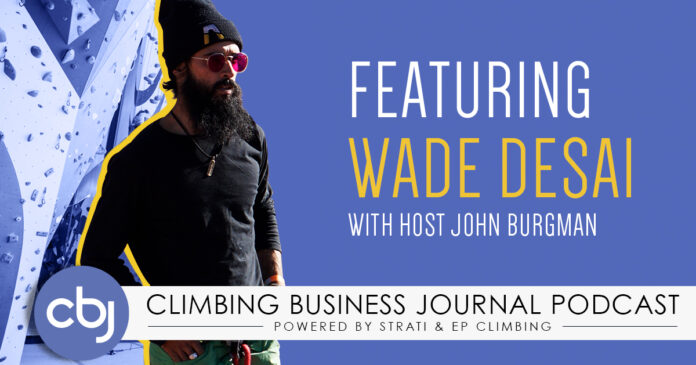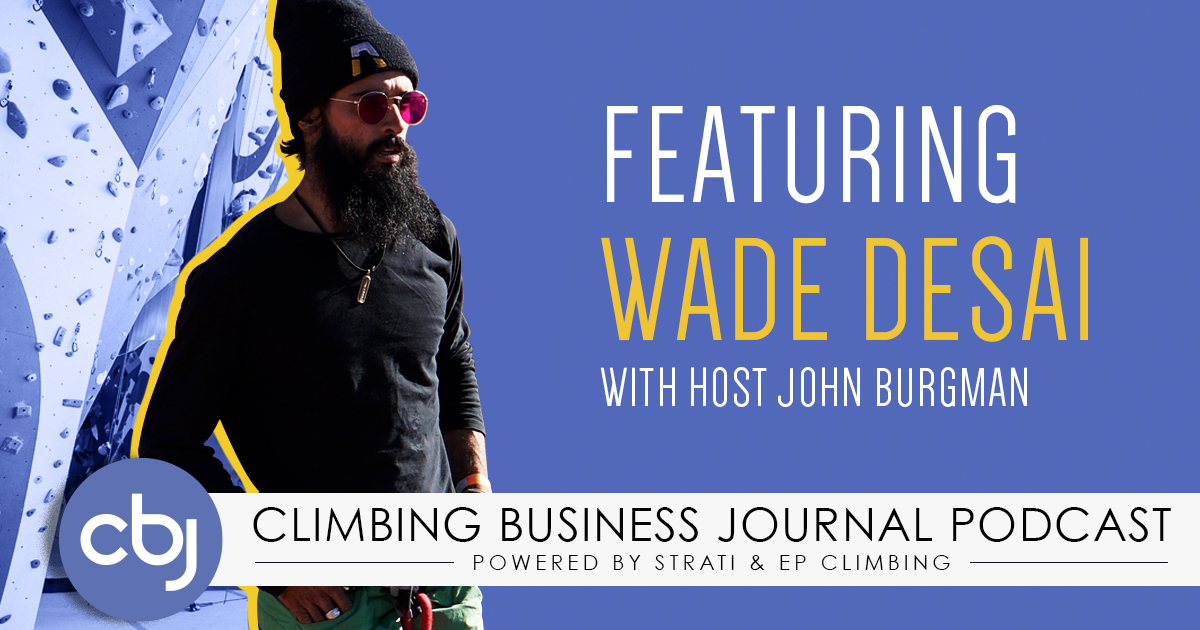
Wade Desai is the Director of Climbing at ASCEND in the Pittsburgh area. As you’ll hear, he certainly loves climbing, but he’s also passionate about slacklining and accomplished at it too. Since starting at ASCEND in 2017, he’s seen slacklining take off as a programming offering and has been helping lead the charge. Could more climbing gyms offer slacklining? And if so, what are some of the steps that a gym should take to get a slacklining program started? Those questions guide today’s conversation, and we’ll also hear more about Desai’s fascinating transition from a doctor in the medical field to a director in the climbing gym industry.
Thank you Strati Climbing and EP Climbing for your support!
And thank you Devin Dabney for your music!
Timestamps
0:00:00 – Intro
0:02:21 – Why the climbing gym industry over a medical career?
0:05:14 – A single moment that led to the “leap of faith”
0:07:53 – The role of slacklining in Wade’s life story and career
0:17:54 – Slacklining and climbing parallels
0:21:01 – History and description of slacklining
0:32:18 – Slacklining in a climbing gym
0:38:46 – First steps to getting a slackline for the gym
0:44:38 – What space is needed for a slackline?
0:53:56 – Preferable slackline location in gyms?
0:59:01 – Insurance aspect of slacklines in gyms
1:04:38 – Changing existing mitigation strategies to include slacklining
1:07:40 – Cost-benefit analysis methods for slackline introduction
1:10:39 – Being prepared for conversations with insurers
1:14:10 – Next steps for gyms interested in slacklining
1:17:04 – Closing
Abridged Transcript
BURGMAN: What was it about the climbing gym industry that was so strong and irresistible that it caused you to do such a big career swerve?
DESAI: There are a lot of things that drew me into the climbing community at large. And climbing facilities, over the duration of the time I’ve been in the climbing community, have definitely undergone a lot of evolution and change. One of the biggest changes is [gyms] are embodying this concept of the third space. Not where you live, not where you work, but that third space where you engage in community. And I think that was one of the biggest draws that I always had with the climbing gyms. Whether I was focused on developing my medical career or whether I was interested in practicing my personal hobbies, when I wanted to decompress or use creative energy or do some sort of workout, it all happened in climbing gyms. And every year that would pass, they would just get better, they’d get upgrades or more budget, and it just became a stronger kind of draw for me.
So, it got to the point where there was finally enough of a draw for me professionally. I was looking at it with the same kind of potential I initially looked at medicine and said, “Wow, I can impact a lot of people in an incredibly positive way using skills that are really natural to me.” And it felt like the balance of where I could have the greatest impact seemed abruptly to have happened overnight, that change, but obviously it took years of a progressive, subconscious place of getting there. It’s a long way of saying that I think it’s that community draw that always brought me to the gyms.
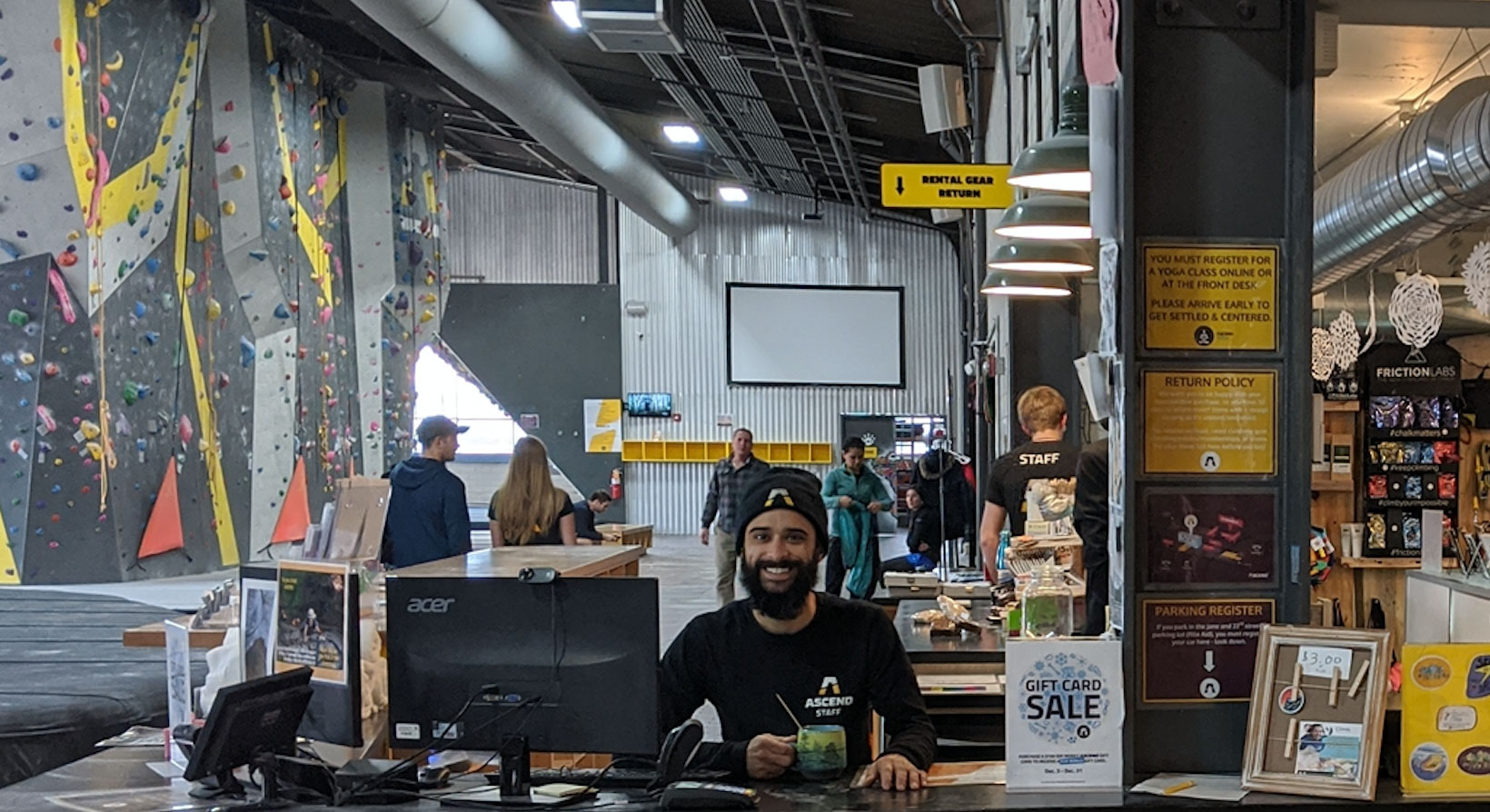
Can you pan out a little bit and give the Wikipedia overview of what slacklining entails?
…In my mind, this action of balancing on webbing—which, as an aside, the act of balancing on any fabric product is called funambulism, which is a fun way of referring to our sport. Tightrope walkers, highwire, slackline…they’re forms of funambulism. Ultimately, all of them are horizontal versions of climbing….
People have practiced balancing on things for thousands of years, but as far as we can tell, in Yosemite sometime in the 40s to 60s, the approaches to many famous climbs are lined with trails that have steel chain-link fencing. And so the climbers, being the natural monkeys they are, as they’re approaching and leaving climbs, would balance on these chains. And they realized it was a great training tool. It wasn’t just fun, and they would do juggling on it and all that kind of stuff. But they realized this helps us with footwork for balance, breath work, mental stability, all of these things…
They had some climbing webbing, so they tied it to a tree, tied it to a van, and they pulled it tight. And the slackline, they found it way more entertaining—the dynamics stretched, the elasticity versus the chain…So it took off in this way that was way more engaging than the chain had been. And ever since then, there have been these chapters of things that have refined the sport in a way that made it even more engaging to the community…
Why would you be a proponent of slacklining being an amenity or slacklining programming being something that should be considered by gyms at large?
…There is definitely some cost-benefit analysis you can do with slacklining. My experience here in our demographic has been that it’s highly beneficial relative to the low cost that it requires. So, there are a bunch of reasons: It has multiple uses. We gained an incredible amount of use with it with our youth, specifically…It serves our members well. It changes things up for youth climbers who may get a little bored with what’s going on day to day. It has an incredible amount of cross-training applicability. Climbing is a lot about footwork, and that is primarily what slacklining is…
And then on the flip side, a primitive slackline setup might cost, top of the line, $250. If you don’t have a place in your gym that already has open mats, you might need to get some gymnastic mats. Maybe that’s $500 or $600. We’re talking like a $1000 investment here, or $1,500-$2,000, and it will last five to seven years and get you an enormous amount of all sorts of programming for all sorts of people, and it’s related to climbing…
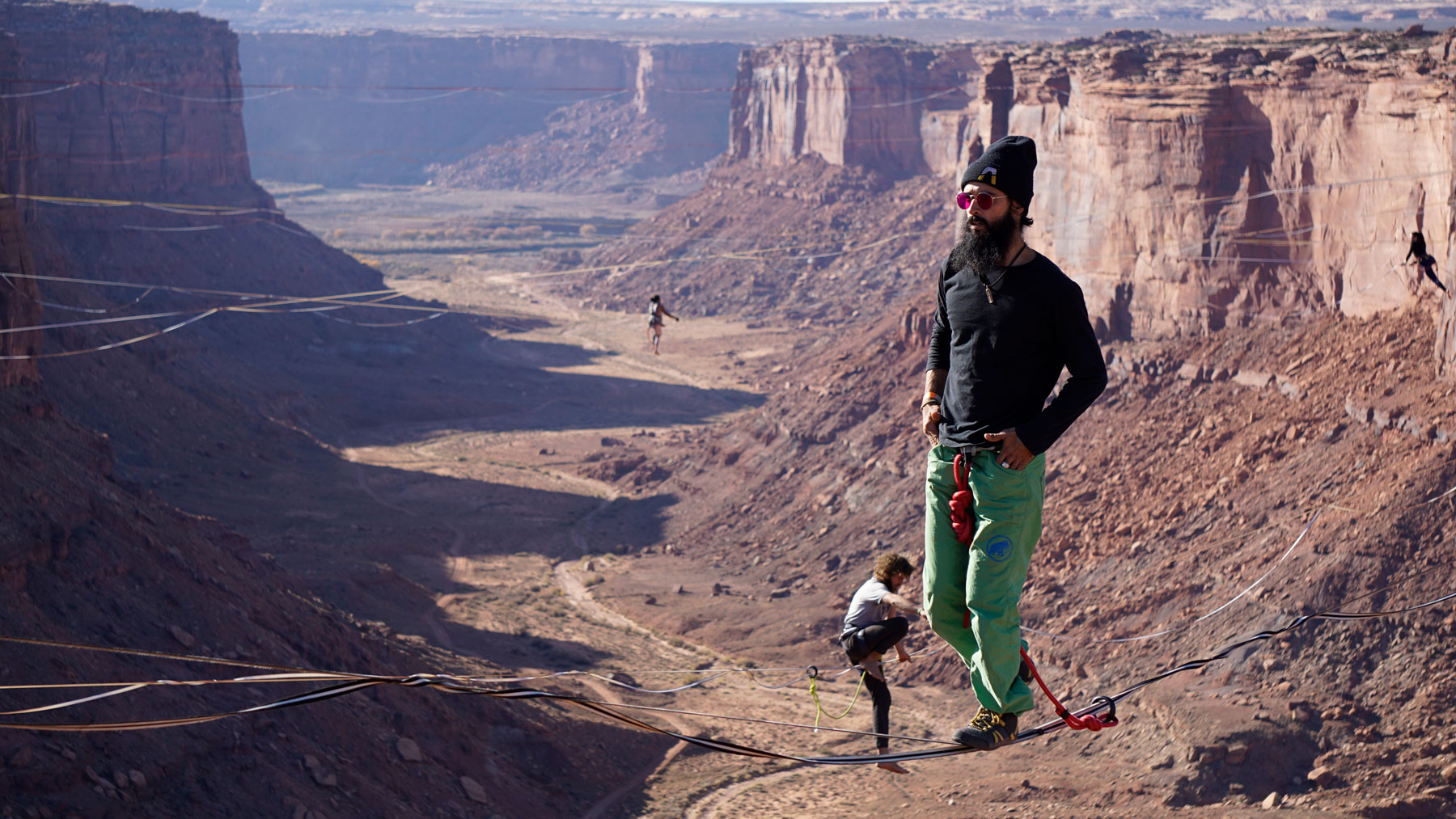
If a gym is wanting to start some slacklining programming, what would you advise for first steps?
So, the one asterisk before I would give the tip is just to recognize that this is a burgeoning activity in some senses. It has a lot of established precedent, but ultimately, if someone wants to develop this in their facility, whether it’s a climbing facility or not, it’s going to be a little bit of an uncharted territory…But ultimately, like anything else we would introduce in our facilities here in Pittsburgh, we look to the industry professionals.
A great analogy is our acro yoga community. There are a lot of people in Pittsburgh who practice this acrobatic type of yoga…There was quite large demand from people to be able to do it in our facilities. And imagine coming to an insurer and saying, “We’d like to do this historically circus activity in our climbing facilities,” which is a very strange conversation. So, the way that you introduce these new, “strange” things is by engaging the closest thing you have to industry professionals. By engaging people in our acro community who had taught at other facilities or other places in the country, or who had or held certifications…laid credence to the fact that they are professionals and treat this with a level of professionalization…
Engage your community, see if you can find people near you who have some level of qualification to speak to doing it safely. Reach out to other facilities around the country who are doing this, like myself. I regularly, at least once a month, converse with people who are working in another facility somewhere in the country trying to do something similar. I give them my experience, my background, my input. I don’t charge them any contracting fees or any of that kind of stuff. I’m just interested in having this continue to grow…
What kind of space would be needed to start some slacklining?
…Where in the gym that is possible is obviously going to depend entirely on your specific circumstances. But the biggest thing is mat coverage. If you can, put a slackline above your mats, specifically mats that protect from head injury, not necessarily crash pads. I generally put stiffer gymnastic pads underneath my slackline so that you can come off with a stiff ankle and land on your feet and not roll an ankle…
A good consideration is trying to put it somewhere where you can have the option of putting a running parallel line above it. That has a lot of uses. Obviously, the overhead line of being able to balance and use something that’s draped above you allows you to practice and advance your level of skill much more quickly and efficiently than just trial and failure, trial and failure…But even cooler is that if you rig it properly, that above line, you can essentially set up a rescue-type setup with a [Petzl] Reeve up there and put someone in a full body harness who perhaps is in a wheelchair and have them walk on the slackline, which we have done in our facilities. It’s incredible, someone who would not be expected to participate in this activity…
Where you decide to put the slackline has a lot of downstream consequences, and trying to set it up so that it will apply to the most number of people in your member base and customer base is what you’re going for. What most people will want is a 40- or 30-foot, one-inch slackline so they can practice. What you need is something that’s going to be applicable to youth and a wide array of weights…so that your prospective participants aren’t limited…
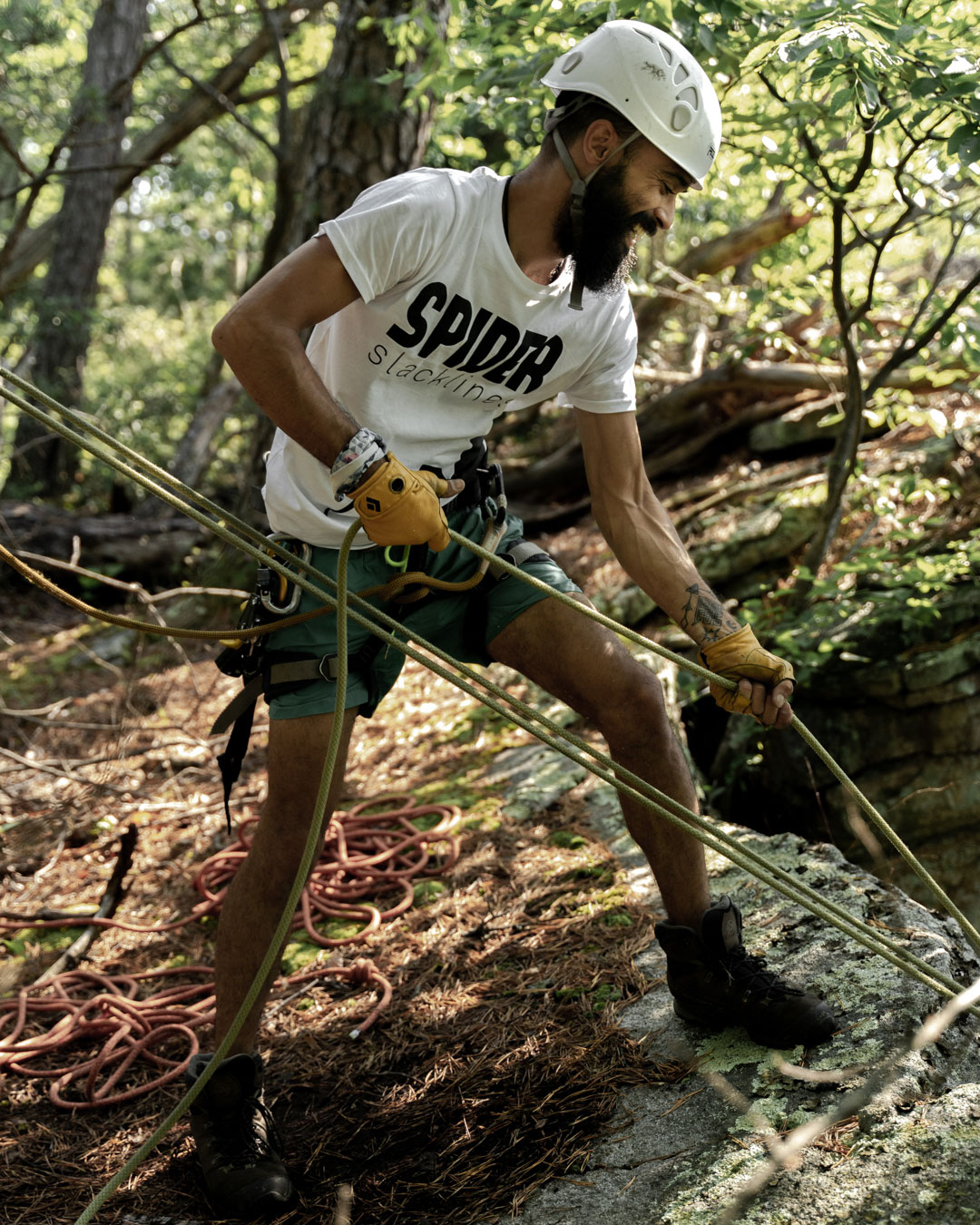
Where does a slackline best situate?
So, the two places we have it in our Pittsburgh facilities are adjacent to our training area—right in our campus board, MoonBoard, spray board area—and then in the newer facility we have it at our ropes wall. At both places I’ve seen incredibly awesome patterns happen. Training wise, it’s great. People are using it in between different normal fitness habits that they have…and it also sort of mentally creates this idea for a lot of people that it is a training tool, which is great, so it now has that culture associated with it…
In the facility in which it’s close to the lead wall, it’s been awesome because whenever there’s downtime for people between burns on climbs, they just hop over onto that thing. It massively helps to de-cluster our fairly narrow ropes corridor, and it keeps kids clustered there, where parents might be roped climbing and they can glance over and see their kids playing on it…In that particular setup, it’s also closer to our front desk, so the front desk can keep an eye on things a little bit…
I think the best location, if I could choose, would certainly be with any kind of adjacent hangout opportunities. If there’s a couch, if there’s a kitchenette, if there’s a little mezzanine area, if there are desks…It definitely has a lot of value in being seen as something you do in your downtime as well, because then a lot of people will be willing to take it on their own outside or to other places…
Can you speak a little bit about objective data pertaining to slacklining and how that can be helpful when talking to an insurer?
…Ultimately, data and metrics are the best way for a case to be painted to insurers that you are working toward one of their primary goals, which is to mitigate risk. So, when we talk about mitigating the risk of slacklining, you have to back up and say to yourself, “What are the risks?” You can’t just look at a slackline and say, “Well, I think the risks are X, Y, Z.” We fortunately live in a day and age where accident reports are kept historically for slacklining; there is the International Slackline Association and Slackline U.S., which keep accident reports and emergency reports, and you can [look into] them and see what is commonly and statistically causing slackline-related issues…Once you create that list, then create a document that expands on it, saying, “These are the ways that we’re going to mitigate that risk…”

John Burgman is the author of High Drama, a book that chronicles the history of American competition climbing. He is a Fulbright journalism grant recipient and a former magazine editor. He holds a master’s degree from New York University and bachelor’s degree from Miami University. In addition to writing, he coaches a youth bouldering team. Follow him on Twitter @John_Burgman and Instagram @jbclimbs. Read our interview Meet John Burgman, U.S. Comp Climbing’s Top Journalist.




